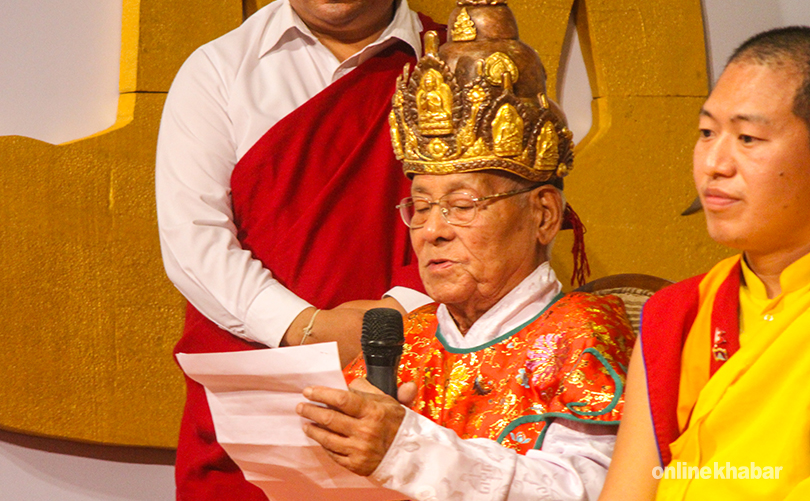Modern-day Buddhism in Nepal dates back to the birth of Gautam Buddha in Lumbini, Nepal. This particular religion and its principles focus on personal spiritual development.
Buddhism is the largest religion in the country after Hinduism. According to the 2011 census, the Buddhist followers cover about 9% of the total population whereas the Tibetan Christian Society 2017 says it is 16%.
The religion further has various subdivisions (or sects). These different subdivisions were reportedly developed after the death of Budhha citing different reasons to continue Buddha’s teaching and honour his principles.
Some of the major sects of Buddhism as practised in Nepal are as follows:
1. Mahayana
Mahayana, translating to the greater vehicle, is currently the most popular and widespread form of Buddhism in the world and also in Nepal. This sect was found 400 years after Buddha’s death. The Mahayana Buddhists believe in the heavenliness of Buddha and also believe in idol worship. They believe salvation is achieved through the grace and help of Buddha and Bodhisattva. In Mahayana, the texts and literature are written in the Sanskrit language. The religion started spreading from the northern countries like China, Korea, Mongolia, Japan, Sri Lanka, and Tibet to all around the world.
Derived from Tibet, this is the most popular sect of northern Nepal, with approximately 3,000 monasteries. The Buddhists of the Shakya clan are believed to have introduced this form of Buddhism in Nepal, during medieval times. It is also the branch of Buddhism which is comprised of several diverse schools, such as Zen, Pure Land, and Nichiren, many of which flourish today in East Asia. Similarly, Mahayana is also classified into further two subjects: namely Shunyavad/Madhyamika and Yogachar/Vijnanavada.
2. Vajrayana

Vajrayana, translating to the way of the diamond or the thunderbolt vehicle, is also known as Tantric Buddhism. According to this religion, salvation is believed to achieve through magical powers called Vajra. This means that narrating mantras is supposed to help you attain magical powers and thus achieve salvation. Followers of this religion also do believe in idol worship and worship Taras as their chief divinity, a goddess of meditation. It is popular in and believed to have spread out from the East Asian countries like Tibet, Bhutan, and also Bengal and Eastern India.
In Nepal, this sect of Buddhism is widespread as an esoteric sect that is predominant in Tibet and Nepal. Newa Buddhism is the form of Vajrayana Buddhism practised majorly by the Newa community of the Kathmandu Valley. This sect, also called Newa Vajrayana Buddhism, has an elaborated tradition of rituals in Nepal and is a very ancient form of practice. The Vajrayana Buddhist guru or gurju (priests) ensure that the Buddhist rituals are practised by domestic Buddhist priests so that the Vajrayana Buddhist scripts and rituals are conserved.
3. Theravada
Theravada, which translates to the school of the elders, is the oldest existing school of Buddhism. The Theravada Buddhism is followed by people in Sri Lanka (Ceylon), Myanmar (Burma), Thailand, Cambodia, and Laos. The text and literature of this sect of Buddhism are written in the Pali language.
In Nepal, the first Theravada vihara named Ananda Kuti was established in 1943 on the hill of Swayambhu Stupa, built by the Ven Dhammaloka Thera (monk). The vihara got surrounded by controversy when it attempted to ordain a lady as a nun. Being aware of the incident, the Rana government asked the monks to cease preaching or leave Nepal.
Afterwards, monks and Ven Amritananda founded the Nepali Buddhist Association (Dharmodaya Sabha) seeking foreign government support. In 1946, Ven Amritanada returned to Nepal with the famous Sri Lankan bhikchu (monk), Ven Narada Mahathera, and obtained permission to preach again at Ananda Kuti. After 1952, they started preaching freely.
Currently, there are several active Theravada organisations in Nepal.
4. The discontinued sect: Hinayana
Hinayana is translated into the lesser or little vehicle. Hinayana is further classified into two different subsects namely Vaibhasika and Sautantrika.
Sometimes, Hinayana is taken as a synonym for Theravada. But, they are not synonymous and those who practice Hinayana, stress they must not be confused with one another.
Practitioners argue Theravada Buddhism existed in Sri Lanka during the third century BC, even before Mahayana whereas the Hinayana sect was developed in India and had an independent existence from that in Sri Lanka.
But, currently, it is said there is no Hinayana sect in existence anywhere in the world. In 1950, the World Fellowship of Buddhists inaugurated in Colombo unanimously decided that the term Hinayana should be dropped when referring to Buddhism existing today in Sri Lanka, Thailand, Burma, Cambodia, Laos, etc.
Comments
Post a Comment